Abstract
Individual identification of ancient human remains is one of the most fundamental requisites for studies of paleo-population genetics, including kinship among ancient people, intra- and interpopulation structures in ancient times, and the origin of human populations. However, knowledge of these subjects has been based mainly on circumstantial archaeological evidence for kinship and intrapopulation structure and on genetic studies of modern human populations. Here we describe individual identification of ancient humans by using short-nucleotide tandem repeats and mtDNAs as genetic markers. The application of this approach to kinship analysis shows clearly the presence or absence of kinship among the ancient remains examined.
Full text
PDF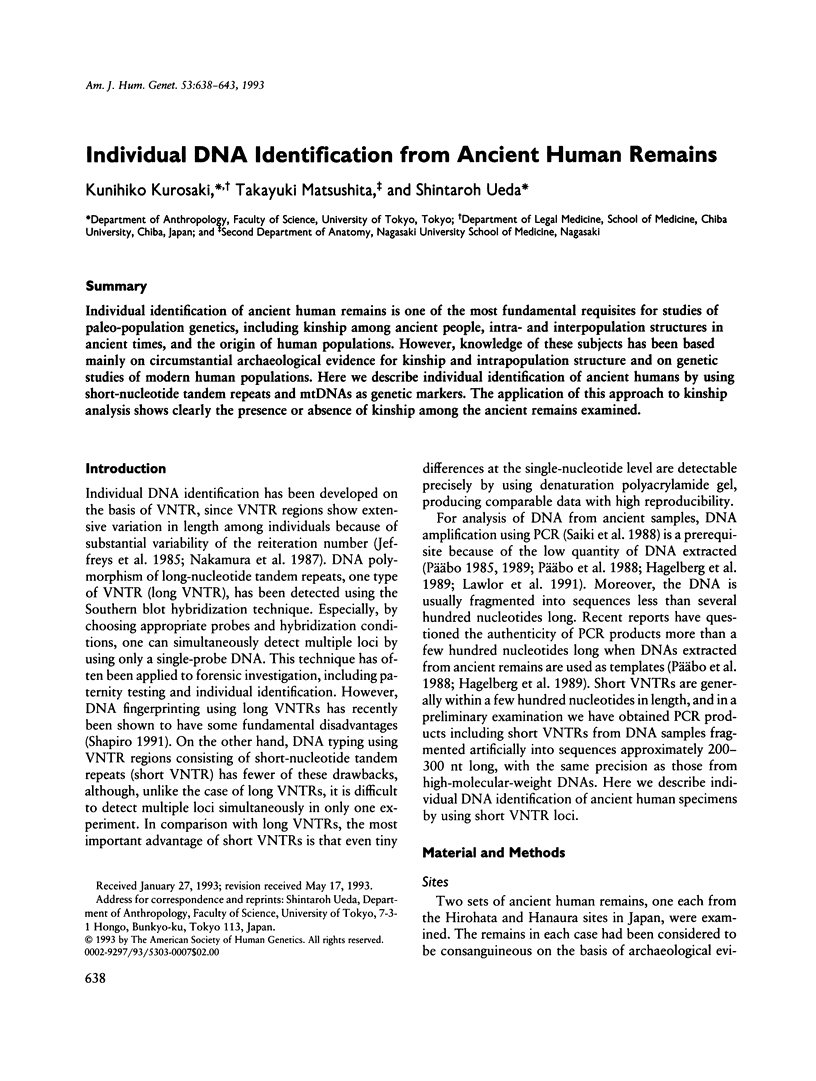
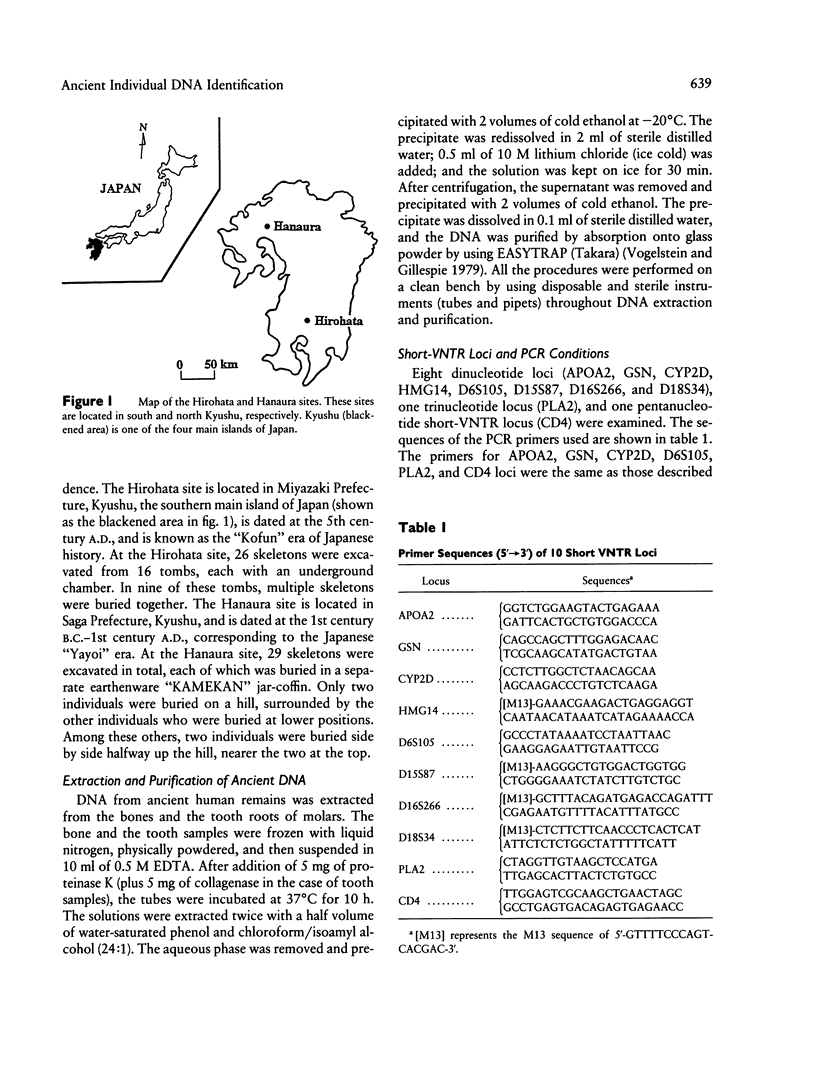
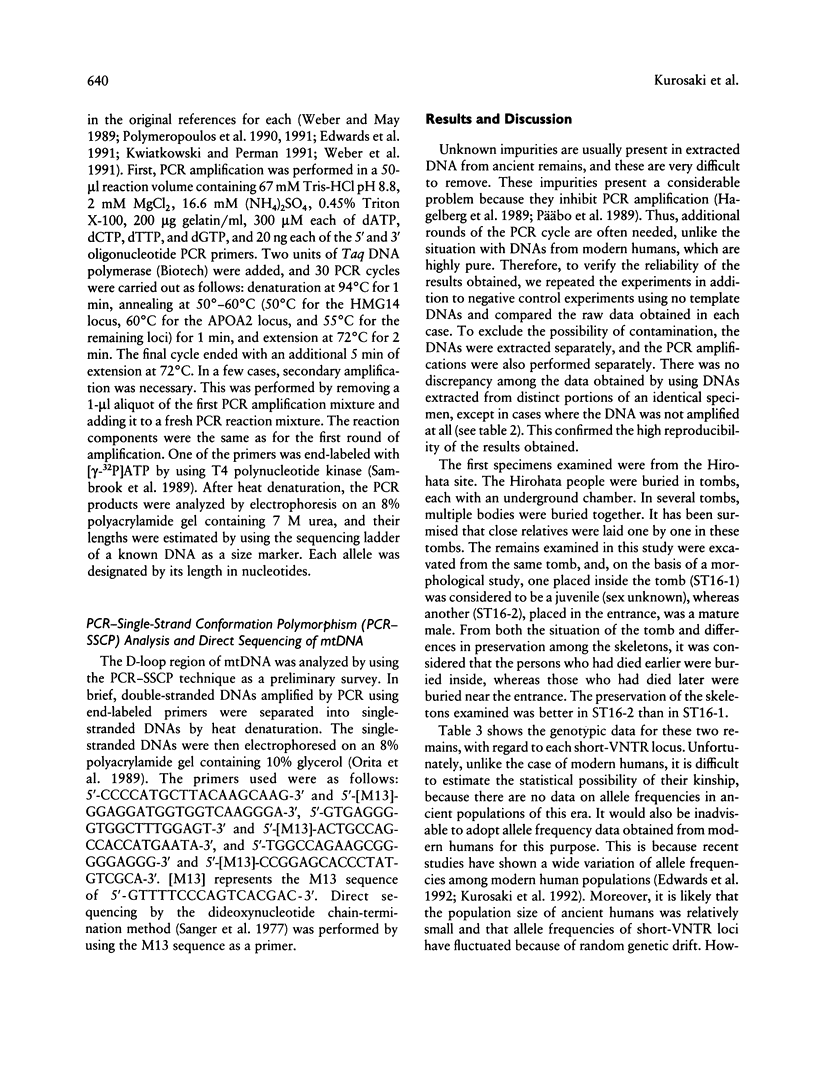
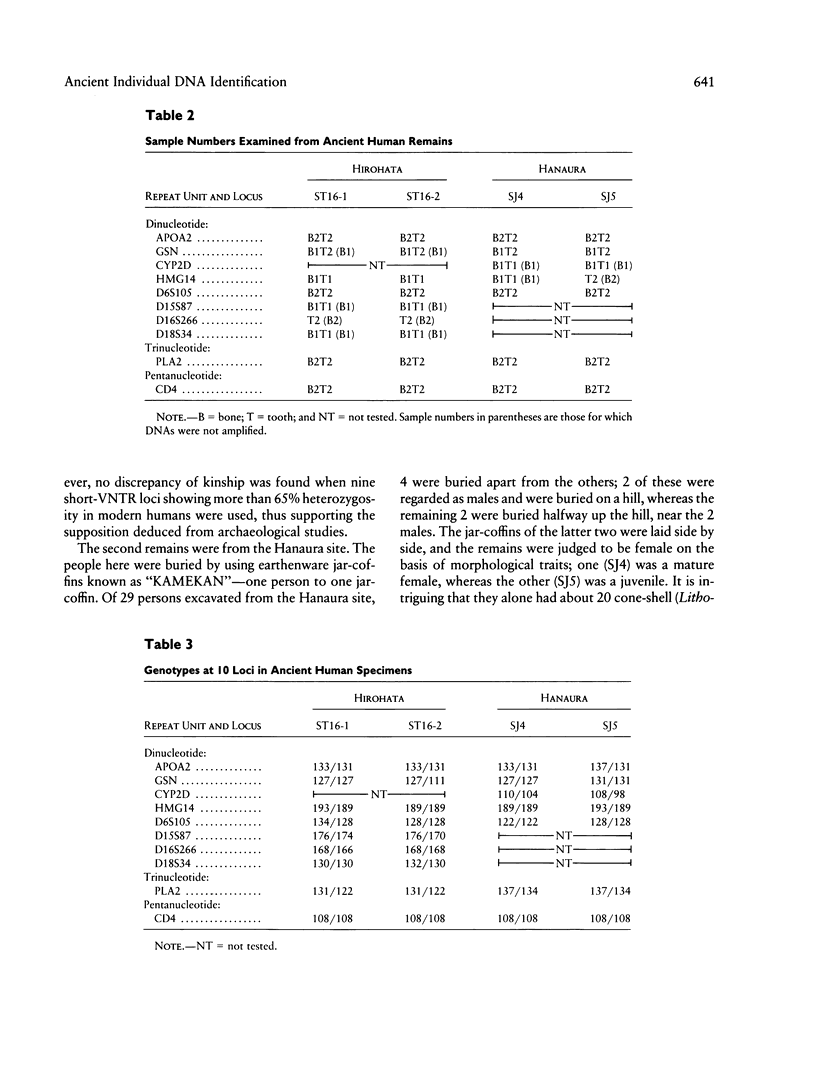
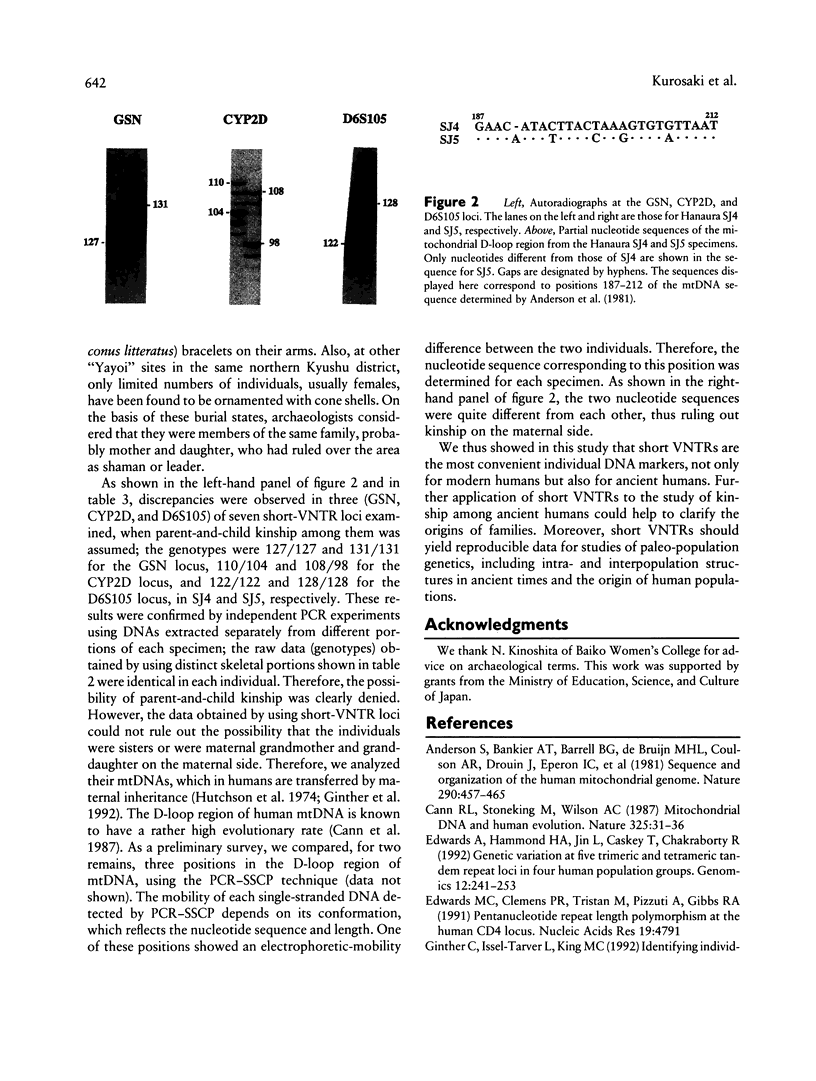
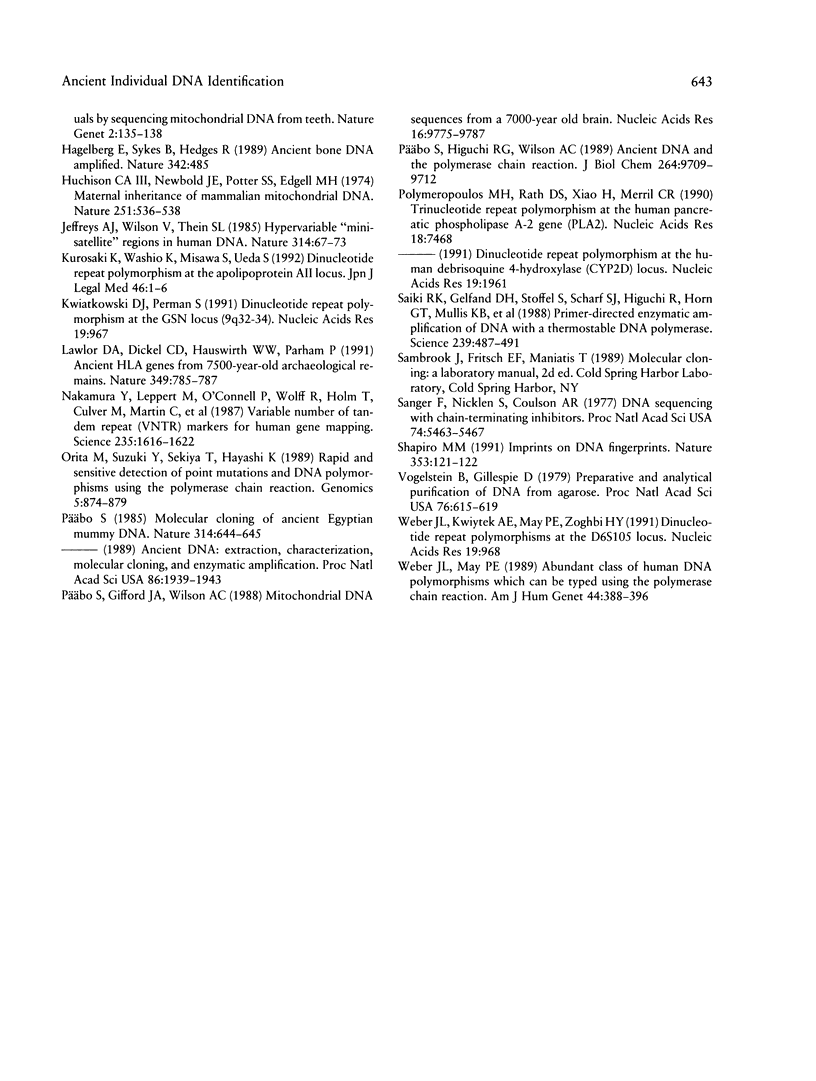
Images in this article
Selected References
These references are in PubMed. This may not be the complete list of references from this article.
- Anderson S., Bankier A. T., Barrell B. G., de Bruijn M. H., Coulson A. R., Drouin J., Eperon I. C., Nierlich D. P., Roe B. A., Sanger F. Sequence and organization of the human mitochondrial genome. Nature. 1981 Apr 9;290(5806):457–465. doi: 10.1038/290457a0. [DOI] [PubMed] [Google Scholar]
- Cann R. L., Stoneking M., Wilson A. C. Mitochondrial DNA and human evolution. Nature. 1987 Jan 1;325(6099):31–36. doi: 10.1038/325031a0. [DOI] [PubMed] [Google Scholar]
- Edwards A., Hammond H. A., Jin L., Caskey C. T., Chakraborty R. Genetic variation at five trimeric and tetrameric tandem repeat loci in four human population groups. Genomics. 1992 Feb;12(2):241–253. doi: 10.1016/0888-7543(92)90371-x. [DOI] [PubMed] [Google Scholar]
- Edwards M. C., Clemens P. R., Tristan M., Pizzuti A., Gibbs R. A. Pentanucleotide repeat length polymorphism at the human CD4 locus. Nucleic Acids Res. 1991 Sep 11;19(17):4791–4791. doi: 10.1093/nar/19.17.4791-a. [DOI] [PMC free article] [PubMed] [Google Scholar]
- Ginther C., Issel-Tarver L., King M. C. Identifying individuals by sequencing mitochondrial DNA from teeth. Nat Genet. 1992 Oct;2(2):135–138. doi: 10.1038/ng1092-135. [DOI] [PubMed] [Google Scholar]
- Hagelberg E., Sykes B., Hedges R. Ancient bone DNA amplified. Nature. 1989 Nov 30;342(6249):485–485. doi: 10.1038/342485a0. [DOI] [PubMed] [Google Scholar]
- Hutchison C. A., 3rd, Newbold J. E., Potter S. S., Edgell M. H. Maternal inheritance of mammalian mitochondrial DNA. Nature. 1974 Oct 11;251(5475):536–538. doi: 10.1038/251536a0. [DOI] [PubMed] [Google Scholar]
- Jeffreys A. J., Wilson V., Thein S. L. Hypervariable 'minisatellite' regions in human DNA. Nature. 1985 Mar 7;314(6006):67–73. doi: 10.1038/314067a0. [DOI] [PubMed] [Google Scholar]
- Kurosaki K., Washio K., Misawa S., Ueda S. Dinucleotide repeat polymorphism at the apolipoprotein AII locus--phenotyping from peripheral blood and hair. Nihon Hoigaku Zasshi. 1992 Feb;46(1):1–6. [PubMed] [Google Scholar]
- Kwiatkowski D. J., Perman S. Dinucleotide repeat polymorphism at the GSN locus (9q32-34). Nucleic Acids Res. 1991 Feb 25;19(4):967–967. [PMC free article] [PubMed] [Google Scholar]
- Lawlor D. A., Dickel C. D., Hauswirth W. W., Parham P. Ancient HLA genes from 7,500-year-old archaeological remains. Nature. 1991 Feb 28;349(6312):785–788. doi: 10.1038/349785a0. [DOI] [PubMed] [Google Scholar]
- Nakamura Y., Leppert M., O'Connell P., Wolff R., Holm T., Culver M., Martin C., Fujimoto E., Hoff M., Kumlin E. Variable number of tandem repeat (VNTR) markers for human gene mapping. Science. 1987 Mar 27;235(4796):1616–1622. doi: 10.1126/science.3029872. [DOI] [PubMed] [Google Scholar]
- Orita M., Suzuki Y., Sekiya T., Hayashi K. Rapid and sensitive detection of point mutations and DNA polymorphisms using the polymerase chain reaction. Genomics. 1989 Nov;5(4):874–879. doi: 10.1016/0888-7543(89)90129-8. [DOI] [PubMed] [Google Scholar]
- Polymeropoulos M. H., Rath D. S., Xiao H., Merril C. R. Trinucleotide repeat polymorphism at the human pancreatic phospholipase A-2 gene (PLA2). Nucleic Acids Res. 1990 Dec 25;18(24):7468–7468. [PMC free article] [PubMed] [Google Scholar]
- Päbo S., Gifford J. A., Wilson A. C. Mitochondrial DNA sequences from a 7000-year old brain. Nucleic Acids Res. 1988 Oct 25;16(20):9775–9787. doi: 10.1093/nar/16.20.9775. [DOI] [PMC free article] [PubMed] [Google Scholar]
- Päbo S., Higuchi R. G., Wilson A. C. Ancient DNA and the polymerase chain reaction. The emerging field of molecular archaeology. J Biol Chem. 1989 Jun 15;264(17):9709–9712. [PubMed] [Google Scholar]
- Päbo S. Molecular cloning of Ancient Egyptian mummy DNA. Nature. 1985 Apr 18;314(6012):644–645. doi: 10.1038/314644a0. [DOI] [PubMed] [Google Scholar]
- Saiki R. K., Gelfand D. H., Stoffel S., Scharf S. J., Higuchi R., Horn G. T., Mullis K. B., Erlich H. A. Primer-directed enzymatic amplification of DNA with a thermostable DNA polymerase. Science. 1988 Jan 29;239(4839):487–491. doi: 10.1126/science.2448875. [DOI] [PubMed] [Google Scholar]
- Sanger F., Nicklen S., Coulson A. R. DNA sequencing with chain-terminating inhibitors. Proc Natl Acad Sci U S A. 1977 Dec;74(12):5463–5467. doi: 10.1073/pnas.74.12.5463. [DOI] [PMC free article] [PubMed] [Google Scholar]
- Shapiro M. M. Imprints on DNA fingerprints. Nature. 1991 Sep 12;353(6340):121–122. doi: 10.1038/353121b0. [DOI] [PubMed] [Google Scholar]
- Vogelstein B., Gillespie D. Preparative and analytical purification of DNA from agarose. Proc Natl Acad Sci U S A. 1979 Feb;76(2):615–619. doi: 10.1073/pnas.76.2.615. [DOI] [PMC free article] [PubMed] [Google Scholar]
- Weber J. L., Kwitek A. E., May P. E., Zoghbi H. Y. Dinucleotide repeat polymorphism at the D6S105 locus. Nucleic Acids Res. 1991 Feb 25;19(4):968–968. doi: 10.1093/nar/19.4.968. [DOI] [PMC free article] [PubMed] [Google Scholar]
- Weber J. L., May P. E. Abundant class of human DNA polymorphisms which can be typed using the polymerase chain reaction. Am J Hum Genet. 1989 Mar;44(3):388–396. [PMC free article] [PubMed] [Google Scholar]



